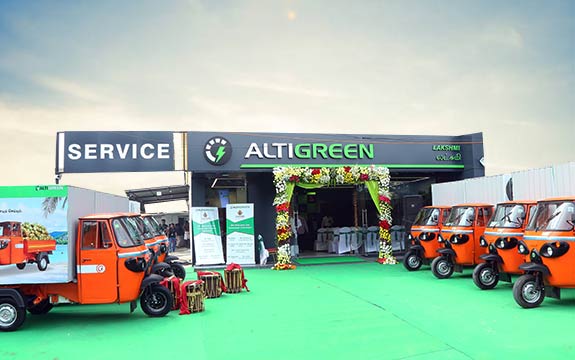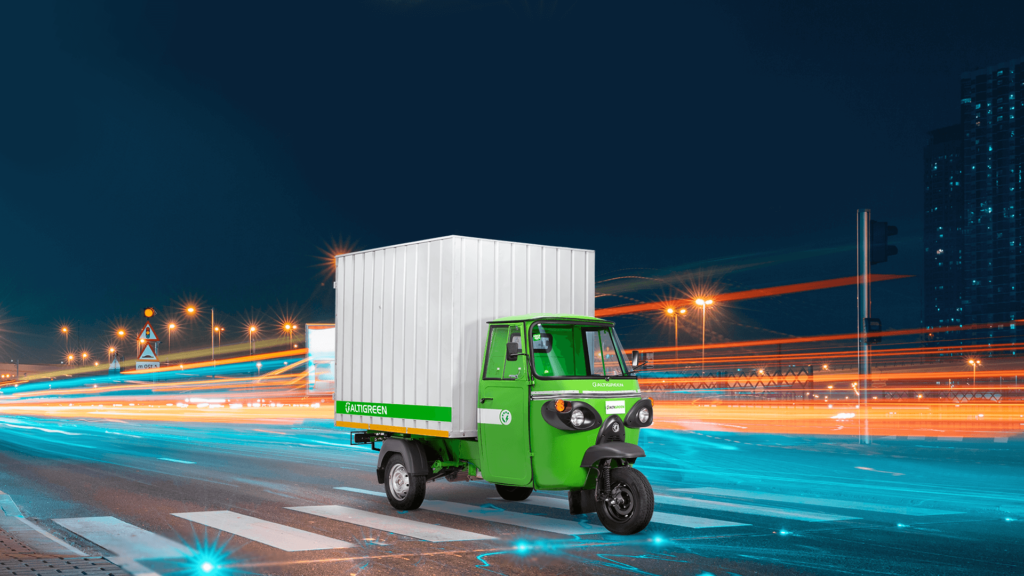
Altigreen, a Bengaluru-based commercial electric vehicle (EV) manufacturer, has developed a new edition of its three-wheeler cargo EV neEV – the neEV Tez — in partnership with energy startup Exponent Energy. From a certain standpoint, this is a huge step forward not only for the Indian e-mobility sector but also for EV lovers all around the world.
The neEV Tez features,
- The neEV Tez has an 8.2kWh e^pack (battery pack).
- The battery pack is manufactured by Exponent Energy utilizing conventional LFP (lithium ferro-phosphate) cell chemistry.
- It has a city drive range of 80-85 km.
- Exponent Energy’s patented liquid-cooled battery charges from 0-100% in 15 minutes at its e^pump charging network.
- The neEV Tez starts at Rs 3,55,000
- It comes with a 5-year/1 lakh-kilometre guarantee.
- It also provides an ‘unprecedented battery warranty’ of 5 years/1.56 lakh kilometers.
The ability to charge the battery from 0-100% in 15 minutes at its e^pump charging network makes neEV Tez the world’s quickest-charging electric three-wheeler.
Every EV enthusiast knows that going from 0 to 100 % within 15 minutes is no easy thing to achieve. But Exponent Energy has achieved the same. Let us look at how they have done it.
0-100% In 15 Minutes: How Is It Done?
This is accomplished by the company’s e^pumps delivering 600A of current to the e^pack (15x industry standard) while managing individual cell characteristics such as thermals to ensure safety, long battery life, and performance consistency even at 50 degrees Celsius.
Since both companies are so confident in their quick charging capabilities they have offered an unprecedented battery warranty, with 3000 fast-charge cycles evaluated!
Partnership That Benefits The Common
Altigreen and Exponent Energy announced their alliance in August 2022, intending to make quick charging a reality for EVs on Indian roadways, and the neEV Tez is the first product to emerge from this collaboration.
In a statement to the media, Dr Amitabh Saran, founder and CEO of Altigreen shared his belief that the neEV Tez will ensure full utilisation of the vehicle due to its extended range and low charging time, resulting in many journeys on a single charge and prospects for significant earnings. While consumers recognise that EVs provide a smoother driving experience, there are myths about them being unpredictable and unreliable, with range and charging time limiting the number of delivery jobs one can accept.

The game-changing neEV Tez offers a new and robust solution with its 15-minute full-charge capabilities. So the next time a consumer asks us, ‘Kitna chalti hai? (How long does it run?)’, we’d like to tell them, ‘Chalti rehti hai! (It runs all the time!),” Dr Saran confidently said.
The Logistics Of Charging
According to Arun Vinayak, co-founder of Exponent Energy, the neEV Tez comes with two charging options. One option is to charge at home using a slow charger and the other is to charge at the e^pump we mentioned earlier. The company now has 20 e^pumps installed in Bengaluru and expects to install 10 more this month as part of phase 1. The company will have 30 e^pumps within a 5 km radius, covering all key places by the end of Phase One.
In phase 2 which is planned to take place within the next six months, the company will have 100 charging stations in Bengaluru, which equals the number of CNG stations in the city.
The e^pumps are expected to be easier to find because the company is developing an app that will allow users to locate the nearest one. “If an e^pump fails for whatever reason, such as a power outage, the app is expected to reroute traffic and it won’t be a problem because they have e^pumps within 2 kilometres of each other.
One Gun Charging Points
Another interesting initiative is that the company is trying to promote one gun (EV charging point or gadget that dispenses petrol/diesel at stations) per e^pump instead of many. We have to take into consideration that almost all other EV charging providers are trying to put as many charging points as possible in a single charging station.
The company’s logic goes like this, “A petrol pump requires a specific amount of space. It should be positioned on a major main road and will necessitate a big petrol bunker. In addition, the number of fuel-powered vehicles necessitates having at least two or three guns at each petrol pump. Because of the short turnaround time, the 15-minute charging system requires only one gun per e^pump.”
Instead of 400-500 concentrated positions, the company is aiming to place up to 100 single guns across the city. It’s fairly simple to put up a single gun 500 metres away from the next rather than putting it together in a single place. With the present slow-charging guns, charging a vehicle takes four to five hours, you have to pay for a lot more real estate, handle several connections, and so on.
“There have been instances where two vehicles enter our e^pump at the same time. Even then, you need just 20-22 minutes from the moment you drive into our e^pump and drive out with a fully charged EV,” says Arun, an official in the company.
Right now it’s the neEV Tez that’ll be using the e^pumps but the company is looking at other categories of vehicles as well.
Three-wheelers Are Key To The EV Charging Revolution
Why do startups believe that the EV charging revolution will begin with the three-wheeler?
The company’s primary concentration is on commercial vehicles. India sells over 20 million two-wheelers every year, although they consume only 5% of our total energy on the road. Passenger cars don’t make a huge difference in terms of sustainability because they only utilise roughly 20% of our energy.
“Three-wheeler passenger vehicles, cargos, four-wheeler LCVs, lorries, and buses are particularly energy demanding. They account for 10% of all vehicles but consume 70% of all energy. These vehicles require the quickest charging; therefore, the pricing points are delicate. They also have batteries weighing more than 100 kg, with truck batteries reaching up to 300 kg. Rapid charging is the only viable option.
Approximately 50% of three-wheelers sold in India are electric. The three-wheeler sector is more prepared for naval technologies than, for example, the heavy truck market, and a lot of last-mile commerce is shifting to electric three-wheelers. The majority of passenger vehicles and two-wheelers are parked and charged at home or work and they don’t require fast charging stations.
Returning to the neEV Tez three-wheeler, it was designed in India with Indian road conditions and temperatures in mind, and it is designed for intercity and intracity transit. neEV is a solution for last-mile delivery and offers 177 cu ft more cargo space than other EVs on the market. It is available in three variants: the High Deck, the Low Deck, and now Tez.
According to the CEO, neEV Tez was designed with all company owners in mind, from those who own a single vehicle to those who own thousands of vehicles in the logistics industry. The company aims to deploy 2,000 neEV Tez three-wheelers in the first phase of commercialization.
You May Also Like
- [READ]: How to start a charging station business in India?
- [WATCH]: Flying cars in Dubai
I am interested in creating a pilot of your 600A charging station in Cuba. Opening a pilot in Cuba will complement the sale of electric tricycles. I am the inventor of three new energy generation and storage systems that can improve the sale of your stations for a transcontinental franchise in the US. Would you please call me directly at my cellular to coordinate potential partnership?
Thank you.
Maximo
Zoo-Mechanics, Inc. Founder
53-58594916 EST
53-78615988 EST home after 9pm